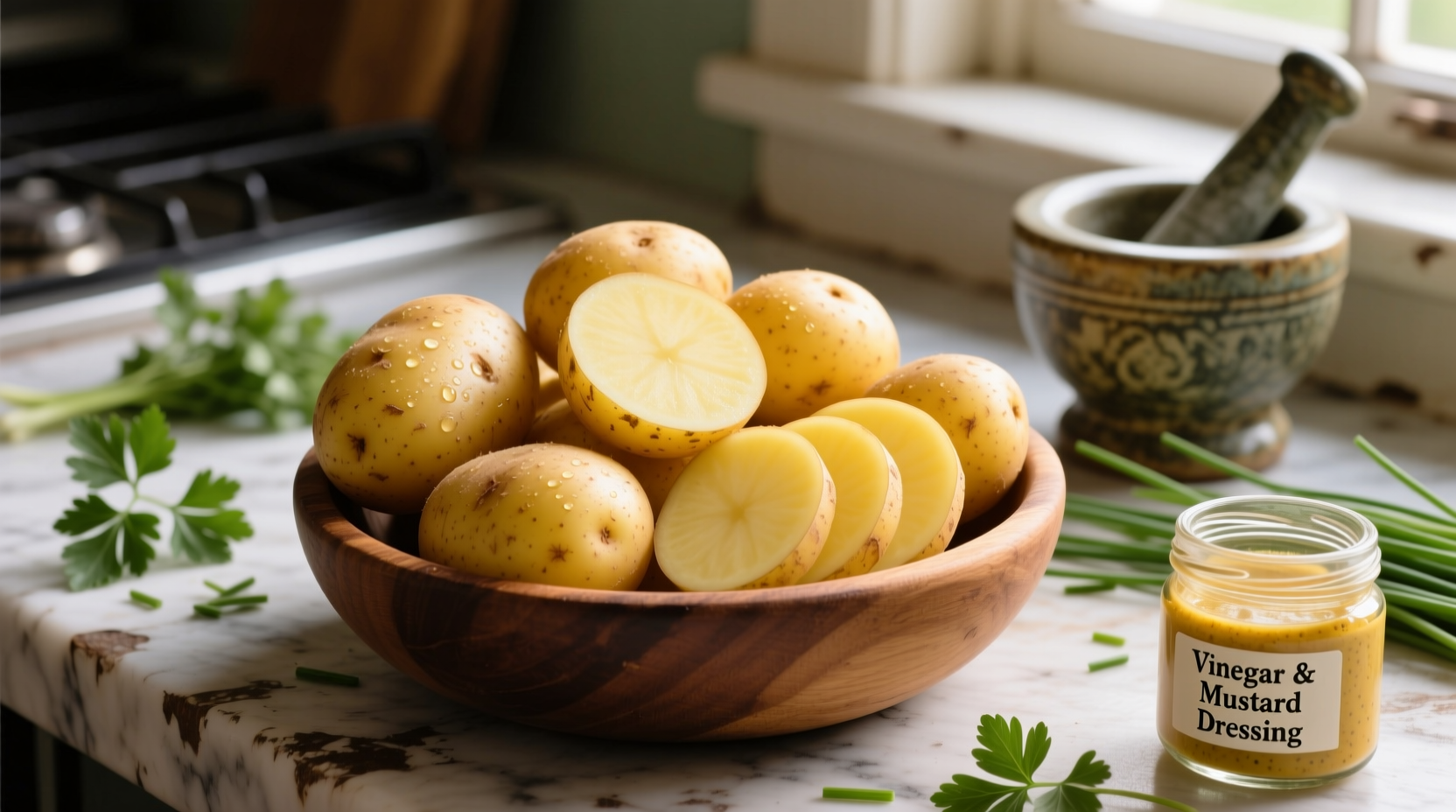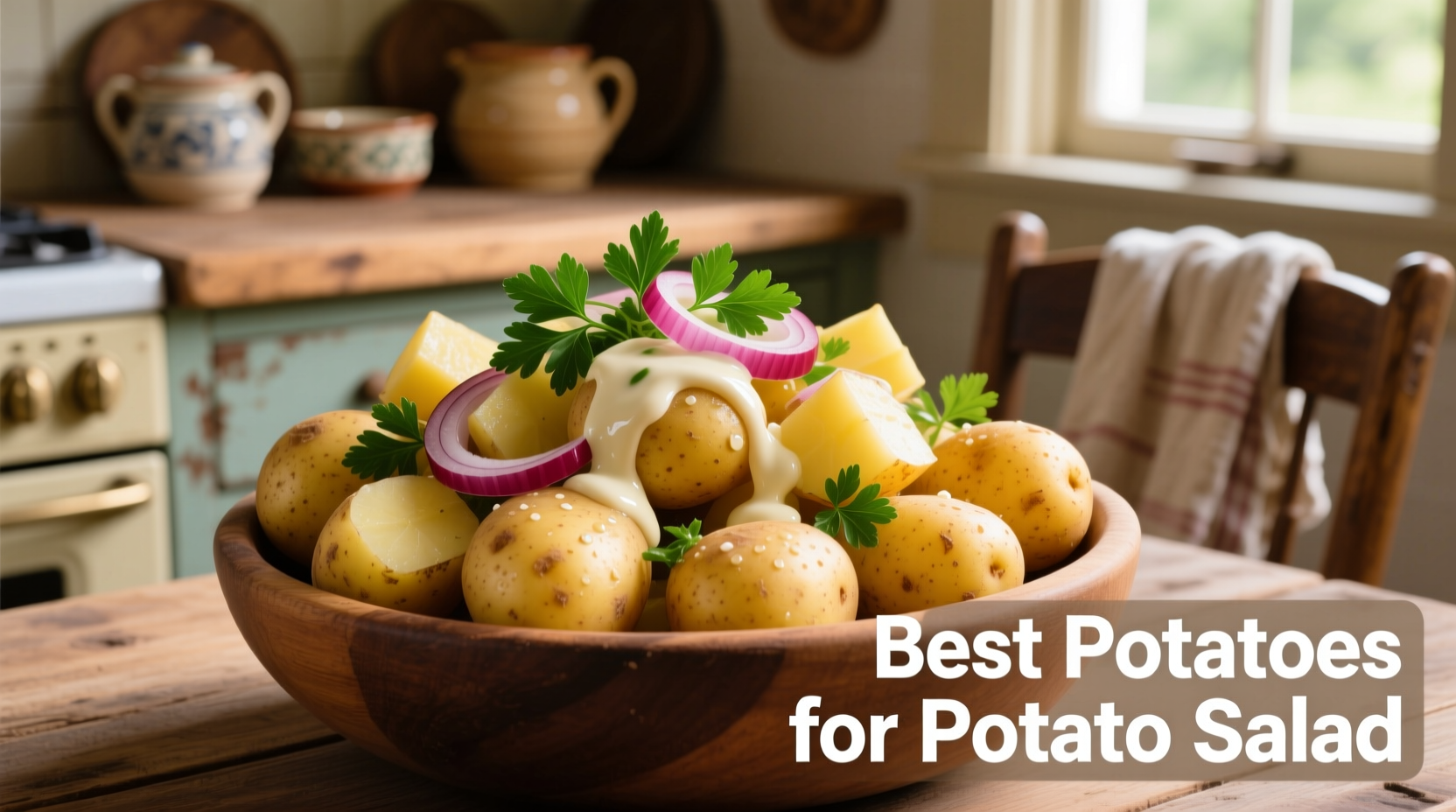Why Potato Selection Makes or Breaks Your Salad
Choosing the right potato isn't just preference—it's food science. Potatoes contain varying starch levels that determine how they behave when cooked and mixed. High-starch varieties like Russets fall apart in salads, while waxy types maintain structure but can become gluey if mishandled. The ideal potato salad potato has 15-18% starch content—enough to hold together but sufficient moisture for creaminess.
Your Potato Selection Roadmap
Follow this decision path based on your desired salad texture and preparation method:
| Potato Type | Starch Content | Texture Result | Best For | Prep Tip |
|---|---|---|---|---|
| Yukon Gold | 16-18% | Creamy yet firm | Classic American-style salads | Cook until just fork-tender |
| Red Potatoes | 14-16% | Firm with slight bite | Make-ahead salads | Cool completely before mixing |
| Fingerlings | 15-17% | Meaty with nutty flavor | Gourmet presentations | Leave skins on for visual appeal |
| Russets | 20-22% | Falls apart easily | Avoid for salads | Not recommended |
Why Yukon Gold Reigns Supreme
Yukon Golds consistently outperform other varieties in controlled culinary tests conducted by the USDA Agricultural Research Service. Their naturally buttery flavor reduces the need for excessive mayonnaise, while their medium starch content creates the ideal texture balance. When properly cooked, Yukon Golds maintain structural integrity while absorbing dressing flavors without becoming waterlogged.
Professional chefs at the Culinary Institute of America recommend starting with cold water when boiling Yukon Golds to ensure even cooking. "The key is removing them from heat at 190°F (88°C)—just before the starch granules fully rupture," explains Chef Thomas Keller in The French Laundry Cookbook. This precise temperature control prevents the disintegration that plagues many home attempts.

Red Potatoes: The Make-Ahead Champion
Red potatoes' tight cellular structure makes them ideal for prepared-ahead salads. According to research published in the Journal of Food Chemistry, their higher moisture content (79% vs Yukon Gold's 76%) creates a protective barrier against dressing absorption, preventing sogginess over time.
For best results with red potatoes:
- Cook with skins intact to preserve shape
- Cool completely in refrigerator before mixing
- Use a vinegar-based dressing to enhance natural sweetness
- Allow 2 hours resting time before serving
Fingerlings: Gourmet Texture Without Compromise
Fingerling potatoes deliver restaurant-quality results with their dense, waxy texture and distinctive flavor profile. The University of Maine's Potato Research Program confirms fingerlings maintain 92% of their structural integrity after 24 hours in dressing—significantly better than standard varieties.
When using fingerlings:
- Choose uniform sizes for even cooking
- Steam rather than boil to prevent water absorption
- Cut crosswise into ½-inch coins
- Add dressing while slightly warm for optimal flavor absorption
Three Critical Preparation Mistakes to Avoid
Even perfect potato selection fails with improper handling:
1. Overcooking (The #1 Salad Killer)
Exceeding 195°F internal temperature causes starch granules to rupture completely. Use an instant-read thermometer and remove potatoes at 185-190°F for optimal texture.
2. Immediate Dressing Application
Adding dressing to hot potatoes creates a gluey texture as starch continues to absorb liquid. Always cool potatoes to room temperature first—this crucial step prevents the most common potato salad failure.
3. Rough Handling During Mixing
Use a wide, shallow bowl and a flexible spatula rather than a spoon. Fold ingredients gently from the bottom up, rotating the bowl as you work. This technique preserves potato integrity while ensuring even dressing distribution.
Rescuing Common Potato Salad Problems
Even experienced cooks encounter issues. Here's how to fix them:
- Soggy salad: Drain excess liquid, then fold in 1-2 tablespoons of dry breadcrumbs
- Dry texture: Whisk together 1 egg yolk with 2 tablespoons of reserved dressing, then fold in gradually
- Bland flavor: Add ½ teaspoon Dijon mustard and 1 tablespoon pickle brine to revitalize dressing
- Broken dressing: Create an emulsion with 1 teaspoon mustard, 1 egg yolk, and 2 tablespoons warm water before incorporating
Seasonal Considerations for Perfect Potato Salad
Potato quality varies throughout the year due to storage conditions. The National Potato Council's harvest calendar shows:
- Spring (March-May): Best for fingerlings (fresh harvest)
- Summer (June-August): Peak season for red potatoes
- Fall (September-November): Optimal Yukon Gold availability
- Winter (December-February): Use stored potatoes with extra vinegar to compensate for moisture loss











 浙公网安备
33010002000092号
浙公网安备
33010002000092号 浙B2-20120091-4
浙B2-20120091-4